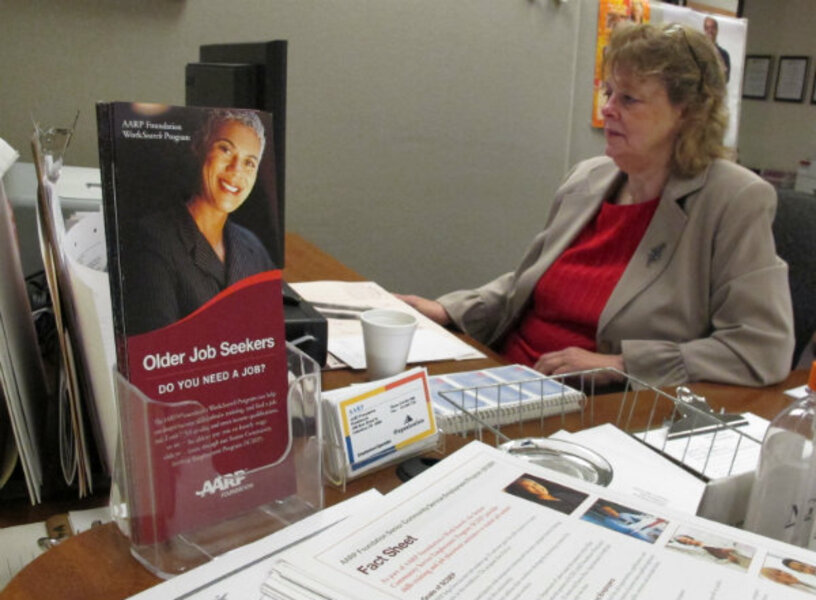Number of long-term unemployed older workers quintupled. The help hasn't.
Loading...
| New York
March’s disappointing employment report reminds us that a strong jobs recovery is still far from reach. There are still 12.7 million Americans looking for a job, and certain groups are having an exceptionally tough time when they go job hunting. The numbers tell a grim story: Not all jobless Americans are treated alike – especially older workers, people age 50 or above.
On one hand, older Americans fare relatively well in the labor market. Last year, they had the lowest average monthly unemployment rate of any age group (6.7 percent). But that rate is more than double their rate in 2007 (3.1 percent). And once older workers lose a job, they are more likely than younger workers to remain unemployed – which is where the hardship really sets in.
During the recession and its aftermath, the number of long-term unemployed older workers more than quintupled, the greatest percentage increase out of all age groups, from 325,000 to 1.8 million.
In 2011, more than half of older jobless workers were out of work for at least six months. And 4 in 10 older jobless workers were jobless for a year or more, a percentage no other age group comes close to. In March, workers age 55 and older had an average duration of unemployment of about 57 weeks.
Prospects are dim for older workers who lose their jobs. With commitments like family or a mortgage, less geographic mobility, and often less capacity to switch career tracks, it’s much more immediately precarious to lose a job when you’re older than when you’re younger.
Retirement prospects and later-life well-being can take a big hit. A national survey of workers who lost their jobs during the recession found that a majority age 55 and older experienced a decline in savings while unemployed. Closer to a traditional retirement age, they then have less time than younger workers to replace lost savings.
Limited job prospects make delaying retirement a difficult option, and make forced early retirement more likely.
The job market has changed, too. Older unemployed workers are more likely to have been laid off from industries experiencing structural shifts, like manufacturing. And even just the idea of submitting a resume by email may be unfamiliar to some. That means older workers may need extra training and resources to land their next job in growth industries.
If and when they do find new work, the wages often aren’t what they used to be. Research suggests older workers are more likely than younger workers to earn less than they did in their previous job, and that older workers who become reemployed may be moving into low-skill, low-pay jobs traditionally filled by youth.
Compounding these obstacles, evidence shows that employers are explicitly excluding the unemployed from hiring consideration. Because this kind of discrimination is more likely to affect those who have been out of work for the longest amount of time, older workers are the most likely victims.
These trends don’t just impact individual workers, either. As the population ages, so does the labor force. Workers age 50 and older make up 32 percent of the workforce, and that is projected to increase to over 35 percent by 2020. If long-term unemployment among older workers stays elevated, pressure will increase on an already overburdened Social Security system and other safety net programs.
That means policymakers need to develop new ways to help older unemployed workers find their way back to good employment and financial self-sufficiency. As part of that, Congress should take note of the 14 states considering legislation that would ban hiring discrimination against the unemployed and immediately pass the federal version, the Fair Employment Opportunity Act.
Unemployed workers continue to face stiff competition for jobs. This legislation would create a level playing field for all unemployed job seekers by prohibiting employers and employment agencies from excluding job applicants solely because they’re unemployed. The legislation would do nothing to alter an employer’s right to select the candidate with the most relevant or the most recent experience.
Additionally, policymakers should ensure that workforce development programs and services are accessible and tailored to the needs of unemployed older workers. Many of these workers just need help navigating today’s web-based job-search landscape. For others, the key to improving employment prospects may be as straightforward as a course in the latest version of Microsoft Office, or as intensive as getting credentialed in a new occupation.
President Obama’s recent proposal for a new Universal Displaced Worker Program holds some promise for offering high-quality job-search assistance, along with access to critical skills training for high-growth and in-demand industries.
Another option for older workers is work-sharing, also known as short-time compensation. The Middle Class Tax Relief and Job Creation Act signed by Mr. Obama in February provides nearly $500 million in temporary funding to states that adopt or expand work-sharing programs. This practice allows employers to avert the need for layoffs by reducing employees’ work hours during periods of slack demand and compensating them with prorated unemployment benefits. For older workers in industries with employment cycles vulnerable to shifting customer demand, a layoff aversion program like work-sharing can provide for a much smoother transition to retirement.
Without specific steps to help older workers uniquely challenged by the downturn, the harsh effects of the Great Recession will continue for years to come. Developing a system that provides some guaranteed level of support (such as the programs mentioned above) to unemployed workers who need and want to return to the workforce should be an American value we can all get behind.
Claire McKenna is a policy analyst with the National Employment Law Project.





